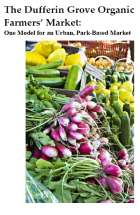
Pages in this Folder:

Related Folders:
See also Department Site Map
Publications:
Market-related videos
Comments?
For the basics, see
- Website & Privacy Policies
- How To Get Involved
- The Role of the Park
Search options:
Department Site Map
Custodians:
posted June 27, 2007
The Rising Cost of Food
From TIME magazine
Thursday, Jun. 21, 2007
The Rising Costs of Food
By John Cloud
All but the wealthiest readers will have noticed by now that food costs have risen this year. In May grocery prices were 4.4% higher than they were the previous May. If 4.4% doesn't sound like much--you spend $104.40 now for a cartful that was $100 a year ago--it's a huge deal to food producers and to budget shoppers, who are making lots of casseroles. The Department of Agriculture anticipates that grocery prices won't significantly fall before January; if the USDA is right, you would have to go back to 1990 to find a bigger single-year increase.
The reasons that food costs more are simple: most of what we eat is shipped great distances, and gas is spectacularly expensive. Also, demand for ethanol has caused the price of corn to spike, and thousands of processed foods contain derivatives like high-fructose corn syrup.
Finally, millions of pounds of citrus froze in California this year; oranges cost nearly a third more in May than they did in May 2006. Climbing food prices sound scary, and reporters have filed a spate of alarmist stories about "soaring"
grocery bills (Good Morning America) that are "way up" (CNN) and causing "sticker shock" (the Bend, Ore., Bulletin). But it actually would be good if food cost a great deal more.
A little historical perspective: despite the recent price run-up, Americans still spend less to feed themselves than any other people on the planet--probably less than any monetized society in history. Just 9.9˘ of each dollar we spend is for food, down from 23.4˘ in 1929. By comparison, 16% of household expenditures in Britain go to food; Brazilians spend 23%, Thais 29%.
Americans don't spend much on food largely because we just don't want to. As a society gets richer, its people tend to use their extra income for things like recreation and education, not daily sustenance. This relationship between food and income--as you get rich, you spend proportionately less to eat--has held so strongly over so many generations that economists have given it a name: Engel's law (for Ernst Engel, a 19th century statistician). The foodie revolution that began in the '70s--arugula over iceberg, short ribs over brisket, etc.--has challenged Engel's law among élites who will pay, say, $80 for a single pound of Nantucket Wild Gourmet cold-smoked salmon. But finding impossibly tender lox is a recreational, not nutritional, pastime.
And anyway, most Americans aren't spending more on food.
We simply don't have to. During the Depression, the government began subsidizing commodities like corn. Today, against all logic, the subsidies continue, and corn-derived snacks and Cokes are so cheap and convenient that, as University of Washington epidemiologist Adam Drewnowski argues, it's perfectly rational, on a dollar-per-calorie basis, to buy them. (Fresh fruits and vegetables aren't subsidized, and by nature they cost more to store and ship.) Drewnowski estimates it would cost 100 times as much to get the same amount of energy from fresh raspberries as from a typical packet of cookies.
Still, there are hidden costs to cheap calories.
Environmental damage is one--in the postwar race to the lowest possible price, farmers applied oceans of pesticides and fertilizers--but obesity is the most obvious. A common objection to ending subsidies is that people will go hungry, and indeed some Americans can't afford to eat: in 2005, according to the USDA, 2.9% of households had at least one member who went hungry at least once the previous year. But the U.S. has a bigger problem with overnutrition. More than half of us are overweight; we spend something like $94 billion annually treating ailments related to overeating.
But if food is more expensive, won't we simply eat more cookies and fewer raspberries? In the short run, yes, although the USDA has launched programs to teach people that while convenience foods have more calories, they usually have fewer nutrients. On a dollar-per-nutrient basis, healthy food is not more expensive. Lab studies have shown that fruits and vegetables are also more satiating--they make you feel fuller than junk food even though they have fewer calories.
In short, we should stop subsidizing junk. To address hunger more directly, we could take that money and use it to increase the miserably small amounts we give people on food stamps. We should also spend a little to help food banks offer fresher locally grown food.
As the great Italian food expert Carlo Petrini points out in his newly translated Slow Food Nation (Rizzoli; 262 pages), agriculture has become "completely detached from the lives of billions of people, as if procuring food had become a matter of course and required no effort at all." But one way or another, we will pay for all that we're eating. CHEAP EATS Percentage of disposable income Americans spend on food [This article contains a chart. Please see hardcopy of magazine.]
- Find this article at: http://www.time.com/time/magazine/article/0,9171,1635836,00.html





 Printer friendly version
Printer friendly version